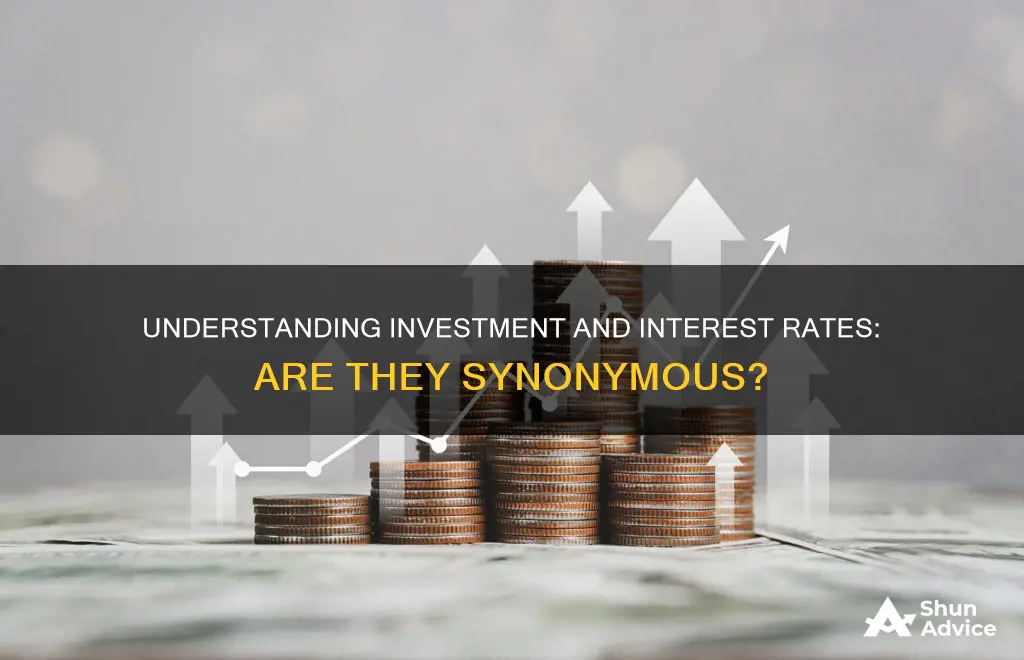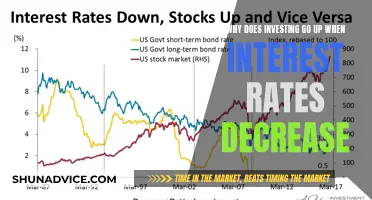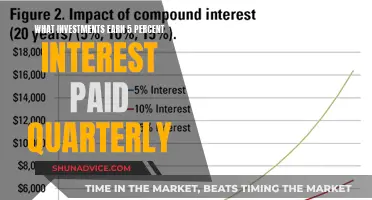
Interest rates and investment rates are not the same thing. The interest rate is the amount of money charged by a lender for the use of assets or money, expressed as a percentage of the principal. The investment rate is the rate of return on an investment, which can be positive or negative depending on the nominal interest rate and the inflation rate.
| Characteristics | Values |
|---|---|
| Investment rate | The rate of return on an investment |
| Interest rate | The rate paid on a loan or investment |
| Simple interest | Interest calculated on the original amount of the investment or loan |
| Compound interest | Interest earned in one period is added to the principal investment, then interest is calculated on the new total |
| Real interest rate | The observed market interest rate adjusted for the effects of inflation |
What You'll Learn

Simple interest vs compound interest
Interest rates are set by central banks as part of their monetary policy to influence economic activity. The nominal interest rate is the interest rate actually paid on a loan or investment. The real interest rate is the observed market interest rate adjusted for the effects of inflation. It reflects the purchasing power value of the interest paid on an investment or loan.
When it comes to investing, there are two types of interest rates to consider: simple interest and compound interest. With simple interest, the interest is calculated only on the principal (original) amount of the investment or loan. This means that the interest you pay (or earn) remains the same each period. For example, if you invest £1000 at a simple interest rate of 5% per year, you will earn £50 in interest each year.
Compound interest, on the other hand, is when the interest earned in one period is added to the principal investment, and then interest is calculated on the new total. Using the same example as above, if you invest £1000 at a compound interest rate of 5% per year, you will earn £50 in interest in the first year. In the second year, you will earn interest on £1050, which is the original £1000 plus the £50 in interest earned in the first year. So, in the second year, you will earn £52.50 in interest.
The difference between simple and compound interest can have a significant impact on the total return of an investment over time. Compound interest can lead to faster growth of an investment because the interest earned is reinvested and earns additional interest. However, it is important to consider the effects of inflation when comparing different investment options. The real interest rate of an investment is calculated as the nominal interest rate minus the rate of inflation. If the inflation rate is higher than the nominal interest rate, the real interest rate will be negative, which means that the purchasing power of the investment will decrease over time.
Keynesian Theory: Interest Rates and Investment Insights
You may want to see also

Real interest rates
The investment rate is not the same as the interest rate. The investment rate is the rate of return on an investment, while the interest rate is the cost of borrowing money. The two rates are related, but they are not the same.
Prospective real interest rates rely on estimates of future inflation over the time to maturity of a loan or investment. Real interest rates also represent the rate of time-preference of a borrower and lender. This means that investors could earn a rate of return that is negative if the inflation rate is higher than the nominal rate of return on their investments.
Understanding Interest on Investments: An Investing Activity?
You may want to see also

Nominal interest rates
The real interest rate reflects the rate of time preference for current goods over future goods. It is calculated as the difference between the nominal interest rate and the inflation rate. Real interest rates are negative if the inflation rate exceeds the nominal rate of an investment. For example, a bond with a 3% nominal rate will have a real interest rate of -1%, if the inflation rate is 4%. Negative rates affect lenders, borrowers, and investors. Investors with longer time horizons should assess their investment returns on an inflation-adjusted basis.
QuickBooks: Deposits and Investments, Simplified
You may want to see also

Central bank interest rates
Interest rates are set by central banks as part of their monetary policy to influence economic activity. The nominal interest rate is the interest rate actually paid on a loan or investment. The real interest rate is the observed market interest rate adjusted for the effects of inflation. It reflects the purchasing power value of the interest paid on an investment or loan.
The nominal interest rate is the interest rate that is set by central banks. It is the rate that is used to calculate the interest that is paid on a loan or investment. The nominal interest rate is also known as the stated interest rate or the contract interest rate.
The real interest rate, on the other hand, is the interest rate that takes into account the effects of inflation. It is calculated by subtracting the inflation rate from the nominal interest rate. The real interest rate reflects the change in purchasing power over time. For example, if an investment is set to earn 4% in interest per year and the rate of inflation for the same time period is 3%, the real interest rate earned on the investment will be 1% (4% - 3%).
Simple interest is calculated only on the principal (original) amount of the investment or loan. This means that the interest paid or earned remains the same each period. Compound interest, on the other hand, is when the interest earned in one period is added to the principal investment, and then interest is calculated on the new total.
Interest: An Investment or a Costly Curiosity?
You may want to see also

Inflation and interest rates
Interest rates and inflation are closely linked. The nominal interest rate is the interest rate paid on a loan or investment, while the real interest rate reflects the change in purchasing power. In other words, the real interest rate is the nominal interest rate minus the rate of inflation.
For example, if an investment is set to earn 4% in interest per year and the rate of inflation for the same time period is 3%, the real interest rate earned on the investment will be 1% (4% - 3%). This means that the real value of the funds deposited will only increase by 1% per year, not 4%. If the funds were placed in a savings account with an interest rate of 1%, and the rate of inflation remained at 3%, then the real value of the funds in savings will actually decrease.
The relationship between interest rates and inflation is important for investors to consider when making investment decisions. If the inflation rate is higher than the nominal rate of return on an investment, investors could earn a negative rate of return. This is because the real interest rate, which takes into account the effects of inflation, will be negative. Investors with longer time horizons should assess their investment returns on an inflation-adjusted basis.
Central banks set nominal interest rates as part of their monetary policy to influence economic activity. They also use real interest rates to gauge the stance of their policy after considering inflation. This helps to ensure stable economic growth and maintain price stability.
Mortgage Interest Rates: Higher for Investments?
You may want to see also
Frequently asked questions
The investment rate is the rate of return on an investment, while the interest rate is the rate charged on a loan.
With simple interest, the interest is calculated only on the principal amount of the investment or loan, and the interest remains the same each period. With compound interest, the interest earned in one period is added to the principal investment, and then interest is calculated on the new total.
Nominal interest rates are set by central banks as part of their monetary policy to influence economic activity. Real interest rates, on the other hand, reflect the change in purchasing power and are calculated by subtracting the inflation rate from the nominal interest rate.







